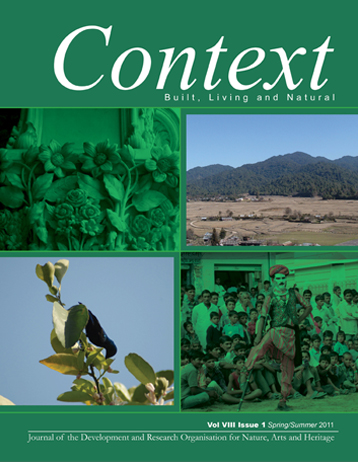Volume VIII Issue 1
About the Volume
Though academia and practitioners have categorised heritage as natural and cultural, tangible and intangible for their own convenience, the fact remains that all these varied aspects of heritage are experienced and lived in totality by traditional communities. For ages, these communities have overlaid their perception of nature with associational significance, expressed in the form of rituals and festivals and integrated with arts and crafts. While ‘heritage conservation’ was considered to be the domain of specialists few years back, recently there is an increasing realisation for community participation in the process specially in case of traditional communities who already possess this know-how. Community led initiatives direct us towards long lasting processes and solutions for conserving all aspects of our heritage.
This issue of context documents some rare expressions such as Vinod Joshi’s recording of a dance festival that was started by an individual in the mid 20th century and continued over decades due to community acceptance and integration with existing festivals. Kunkuma Devi studies the interdependence of festivals and urban form. The listing process of Surat has been presented as a model for documentation of urban heritage and a prerequisite for shaping any urban heritage management policy.
P S Ramkrishnan brings to light the close link that traditional societies have with their natural ecosystems and biodiversity, resulting in an ‘eco-culture’ with its knowledge systems that need to be integrated at various levels with formal systems. Amita Sinha’s article demonstrates the strong associations between man and his natural landscape; an overlay that has been reinterpreted and emphasised, multiple times in history.
Anwar Punekar stresses on the need for an interdisciplinary and integrated approach for conserving historic cities, indicating the streams such as urban design and transport planning as inseparable partners to urban conservation. Manu Mahajan and Kanak Tiwari emphasise on ‘popular history’ and ‘public memory’ as an effective means of conserving and maintaining our heritage and restoration of the Hussainabad Clock Tower, Lucknow is a case of city residents valuing their heritage and taking voluntary initiatives to conserve it.
Chhoti Haldwani, a village in Uttarakhand, is a self sustaining model for community led tourism, while Basgo in Ladakh is a very good example of the community conserving its sacred heritage. Both these initiatives were possible through the support of external resources, but the significant point is that the community made efforts to maintain what it ‘valued’
.The Editorial Team
Contents
About the Volume
Compiling Records
The Geendar Dance Festival of Momasar: A unique tradition of Shekhawati region - Vinod Joshi
Role of Festivals in Shaping Urban Form: Temple towns of Tamil Nadu - Kunkumadevi Sivaraman
Documenting Built Heritage: The case of Surat - Manvita Baradi and Meghna Malhotra
Methods and Approaches
Eco-Cultural Issues and Sustainability - P S Ramakrishnan
Sacred Landscapes of Govardhan in Braj: Imagined, enacted and reclaimed - Amita Sinha
Enabling Interdisciplinary and Integrated Approaches: The case of Bijapur - Anwar Punekar and Irshad Punekar
Recounting History: A pre-Shahjahanbad quarter in Old Delhi - Manu Mahajan and Kanak Tiwari
Restoration of the Hussainabad Clock Tower, Lucknow - Akhilesh Agarwal and Paritosh Chauhan
Sustainable Solutions
Community Based Tourism: Chhoti Haldwani - Anjali Bharthari Ravi
Temple Guardians: A community’s initiative in conserving its sacred heritage - Tara Sharma and Mark Weber
Book Reviews
Delhi: A living heritage by INTACH Delhi Chapter - Reviewed by Jyoti Pandey Sharma
Himalayan Traditional Architecture with special reference to the western Himalayan region by O C Handa - Reviewed by Cheena Kanwal
Heritage Album
Arabesque: A vital element of ornamentation in Islamic Architecture - Mohammad Arif Kamal and Murat Cetin
Radhasoami Samadh, Agra: Stone crafts as medium of narration Smriti Saraswat
Conservational Significance of Farm Houses in the Hinterland - Maharaj K Pandit

